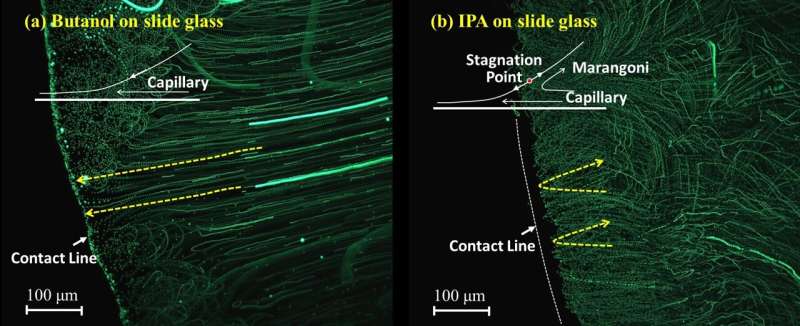This article has been reviewed according to Science X's editorial process and policies. Editors have highlighted the following attributes while ensuring the content's credibility:
fact-checked
peer-reviewed publication
trusted source
proofread
Expanding on the fundamental principles of liquid movement

From the rain drops rolling down your window, to the fluid running through a COVID rapid test, we cannot go a day without observing the world of fluid dynamics. Naturally, how liquids traverse across, and through, surfaces is a heavily researched subject, where new discoveries can have profound effects in the fields of energy conversion technology, electronics cooling, biosensors, and micro-/nano-fabrications.
Now, using mathematical modeling and experimentation, researchers from Kyushu University's Faculty of Engineering have expanded on a fundamental principle in fluid dynamics. Their new findings may lead to more efficient product development in many liquid-based industries such as high-end electronics manufacturing and lab-on-a-chip disease diagnosis.
"We are living in an ever-present world of liquid and flow," explains Assistant Professor Zhenying Wang, the first author of the study that was published in the Journal of Fluid Dynamics. "Over the decades, scientists have made efforts to mathematically describe the seemingly simple phenomena of liquid flow and spreading. For example, Tanner's law describes how a droplet of water spreads on a solid surface over time."
However, these equations remain incomplete. Even the classic Tanner's law is only valid for non-volatile liquids like oil. The law becomes less reliable when it comes to volatile liquids like water, alcohol, and perfumes due to the thermodynamics between the air, liquid, and surface coming into play.
"Therefore, we looked into the current laws in hopes of expanding our understanding of the dynamics of volatile liquids," continues Wang. "We began by mathematically introducing parameters that reflect how volatile liquids react under similar conditions when Tanner's law was derived."
The team—in collaboration with Prashant Valluri of the University of Edinburgh and George Karapetsas of Aristotle University of Thessaloniki—then conducted a series of experiments carefully imaging the movement and thermodynamics of volatile liquids. These two approaches allowed the researchers to scale up the established fluid dynamic principles and put together a more diverse picture of the physics of volatile liquids interacting with a surface and the air.
"The work here depicts a vast range of real cases and draws a more complete picture of liquid dynamics that could not be explained simply by Tanner's law," explains co-author of the paper Associate Professor Chihiro Inoue.
"At a more practical level, these results could play a significant role in various liquid-based industries, for example in the cooling of electronics and other energy devices. The world of fluid dynamics can be very meticulous, but careful examination of it is required if we hope to decipher the fundamental flows around us."
More information: Zhenying Wang et al, Role of volatility and thermal properties in droplet spreading: a generalisation to Tanner's law, Journal of Fluid Mechanics (2024). DOI: 10.1017/jfm.2024.385
Journal information: Journal of Fluid Mechanics
Provided by Kyushu University





















